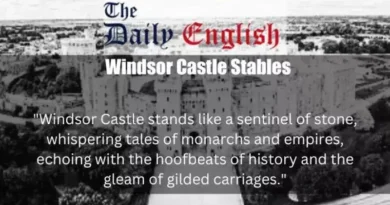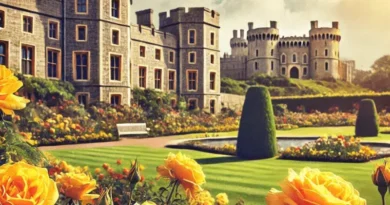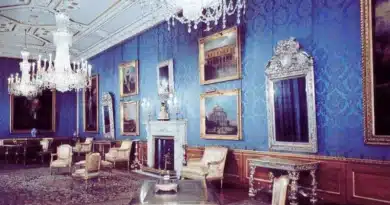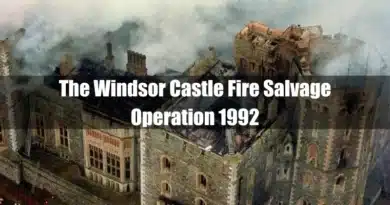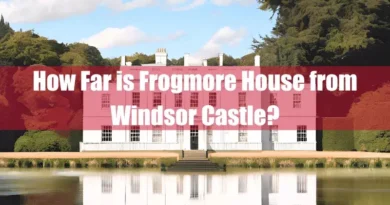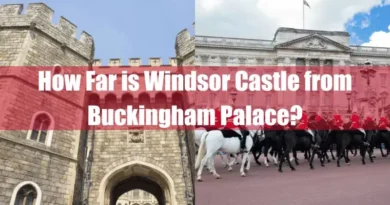The Beauty of Windsor Castle
Windsor Castle, located in Berkshire, England, is the world’s oldest and largest inhabited castle, serving as a royal residence for nearly millennia. Built in the 11th century by William the Conqueror, the castle has evolved from a strategic fortification into a symbol of British heritage. Its architecture showcases a blend of styles, with the Round Tower standing prominently and St George’s Chapel exemplifying Gothic design. The State Apartments house an extensive art collection, including works by Rembrandt and Rubens. Despite modernisations, Windsor Castle retains its historical charm, offering visitors a glimpse into the monarchy’s enduring legacy.
Takeaways
| Key Points |
|---|
| Windsor Castle, the world’s oldest and largest inhabited castle, is a magnificent royal residence renowned for its architectural grandeur, historical significance, and beautifully maintained grounds. |
| Dominating the skyline, the Round Tower stands at the castle’s core, originally built in the 12th century and later heightened by Sir Jeffry Wyatville in the 19th century; it now houses the Royal Archives. |
| St George’s Chapel, a masterpiece of Perpendicular Gothic architecture, is the spiritual home of the Order of the Garter and the resting place of monarchs such as Henry VIII and Queen Elizabeth II. |
| The lavishly decorated State Apartments showcase an extraordinary art collection featuring works by Rembrandt, Rubens, and Van Dyck, with the Grand Reception Room epitomising royal opulence through its gilded interiors and grand chandeliers. |
| Enhancing the castle’s scenic beauty, the East Terrace Garden and Windsor Great Park provide stunning landscapes, while the Long Walk, a 2.65-mile tree-lined avenue, offers breathtaking vistas leading to the Copper Horse statue of George III. |
Introduction
Windsor Castle stands as a testament to England’s rich history, serving as a royal residence for nearly a millennium. Located in Berkshire, it is the world’s oldest and largest inhabited castle, reflecting the architectural and cultural evolution of the nation. Beyond its role as a royal home, Windsor Castle has been a site of significant historical events, architectural transformations, and artistic patronage, embodying the enduring legacy of the British monarchy.
Historical Background
Origins and Founding by William the Conqueror
Following his victory at the Battle of Hastings in 1066, William the Conqueror initiated the construction of Windsor Castle around 1070. Strategically positioned on a chalk hill overlooking the River Thames, the site was chosen for its defensive advantages and proximity to London. The original structure was a motte-and-bailey design, featuring a wooden keep atop a man-made mound encircled by a protective enclosure. This fortification was part of William’s broader strategy to establish a network of castles securing his reign over England.
Evolution Through Different Monarchs and Eras
Throughout the centuries, Windsor Castle has undergone numerous transformations under various monarchs:
- Henry II (1154–1189): Replaced the original wooden keep with a stone structure, enhancing the castle’s defences and establishing its status as a royal residence.
- Edward III (1327–1377): Initiated an extensive reconstruction, converting the castle into a symbol of royal prestige. He founded the Order of the Garter in 1348, with St George’s Chapel serving as its spiritual home.
- Charles II (1660–1685): Following the Restoration, he commissioned significant Baroque-style renovations, transforming the State Apartments with opulent interiors to rival European palaces.
- George IV (1820–1830): Embarked on an ambitious Gothic revival project under architect Sir Jeffry Wyatville, reshaping the castle’s skyline and modernising its facilities.
- Queen Victoria (1837–1901): Made Windsor her principal residence, further enhancing its status as a royal and national symbol.
Architectural Evolution

Medieval and Tudor Influences
The medieval period saw Windsor Castle fortified with stone walls and expanded living quarters. St George’s Chapel, begun by Edward IV in 1475 and completed under Henry VIII in 1528, stands as a masterpiece of Perpendicular Gothic architecture. This era also introduced the iconic Round Tower, central to the castle’s design.
Georgian and Victorian Enhancements
Under George IV, the castle experienced a Gothic revival transformation. Sir Jeffry Wyatville was commissioned to redesign the castle, leading to the elevation of the Round Tower and the creation of grand State Apartments adorned with Rococo, Gothic, and Baroque furnishings. Queen Victoria’s reign further solidified the castle’s role as a royal residence, with minor modifications reflecting contemporary tastes.
Modern Restorations and Renovations
The 20th century presented challenges, notably the 1992 fire that caused extensive damage. A meticulous restoration project ensued to preserve historical accuracy while incorporating modern safety measures. Today, Windsor Castle seamlessly blends its rich historical legacy with contemporary functionality, continuing to serve as a royal residence and a symbol of British heritage.
Windsor Castle’s architectural journey mirrors the dynamic history of the British monarchy, showcasing resilience and adaptation through the ages.
Notable Structures Within Windsor Castle
Windsor Castle, an enduring symbol of British heritage, encompasses several significant structures, each with its unique history and purpose.
The Round Tower

Situated at the heart of Windsor Castle, the Round Tower stands atop a 50-foot artificial mound known as the motte. Originally constructed in the 12th century, its elevated position offered strategic defensive advantages, allowing for extensive views of the surrounding landscape and the River Thames. In the early 19th century, architect Jeffry Wyatville increased the tower’s height by 30 feet to enhance its imposing presence. Today, the Round Tower houses the Royal Archives and the Royal Photograph Collection, serving as a repository for invaluable historical documents and images. While the tower itself is not regularly open to the public, its iconic silhouette remains a central feature of the castle’s skyline.
St George’s Chapel

St George’s Chapel is a prime example of Perpendicular Gothic architecture located in the Lower Ward of Windsor Castle. Constructed between 1475 and 1528, the chapel features intricate stone fan vaulting, magnificent stained glass windows, and ornate wooden choir stalls adorned with the heraldic emblems of the Knights of the Garter. As the spiritual home of the Order of the Garter, Britain’s oldest order of chivalry, the chapel has been the site of numerous royal ceremonies, including weddings and funerals. Notably, it houses the tombs of monarchs such as Henry VIII, Jane Seymour, and Charles I, making it a place of significant historical and cultural importance.
State Apartments
The State Apartments, located in the Upper Ward, comprise a series of grand rooms used for official functions and ceremonies. These rooms reflect a range of architectural styles, primarily the work of architect Jeffry Wyatville in the early 19th century. Each room is designed to showcase a particular style, with the Grand Reception Room exemplifying Rococo design, featuring a French ceiling and restored Gobelins tapestries. The White, Green, and Crimson Drawing Rooms are adorned with carved, gilded wooden panels known as trophies, depicting weapons and spoils of war. These rooms serve as venues for state banquets, official receptions, and other ceremonial occasions, highlighting the castle’s role as a working royal residence.

The Order of the Garter
Established in 1348 by King Edward III, the Most Noble Order of the Garter is Britain’s oldest and most prestigious order of chivalry. Dedicated to Saint George, the patron saint of England, the order honours individuals who have made significant contributions to public service and national life. Membership is limited and includes the Sovereign, the Prince of Wales, and twenty-four Companion Knights, alongside Royal and Stranger (foreign) Knights. The annual Garter Day service is held in June at St George’s Chapel, where new members are invested with the order’s insignia in a ceremony rich in tradition and pageantry. The event includes a colourful procession of the knights in their ceremonial robes and hats, reflecting the enduring legacy of this historic order.
These structures and traditions collectively contribute to the rich tapestry of history and culture that defines Windsor Castle, offering insight into its role as a royal residence and a symbol of continuity in British heritage.
Gardens and Grounds

Windsor Castle is not only renowned for its architectural grandeur but also for its meticulously maintained gardens and expansive grounds, which have evolved over centuries to enhance the castle’s majestic setting.
Description of the Castle’s Parks and Gardens
The castle is encircled by beautifully landscaped gardens that reflect various historical periods and horticultural styles. The East Terrace Garden, originally designed for George IV in the 1820s, features formal flowerbeds and a central fountain, offering a serene retreat with views over the surrounding parkland. This garden was opened to the public for the first time in over 40 years in 2020, allowing visitors to appreciate its historical significance and beauty.
Beyond the immediate castle grounds lies Windsor Great Park, encompassing approximately 5,000 acres of parkland, woods, and gardens. Once a royal hunting ground, the park now provides a habitat for a variety of wildlife and includes notable features such as the Savill Garden and Virginia Water Lake.
The Long Walk and Its Vistas

A prominent feature of Windsor Great Park is the Long Walk, a straight, tree-lined avenue extending nearly 2.5 miles from the George IV Gateway at Windsor Castle to the Copper Horse statue atop Snow Hill. Commissioned by King Charles II in the late 17th century, the Long Walk offers visitors a picturesque route with sweeping views of the castle. The avenue is flanked by rows of trees, originally elms, which have been replanted over the years due to disease, with species such as oak and London plane now predominating.
The Copper Horse statue, erected in 1829, depicts King George III on horseback and serves as a focal point at the southern end of the Long Walk. From this vantage point, one can enjoy panoramic views of Windsor Castle framed by the park’s lush greenery.
Queen Mary’s Dolls’ House

Queen Mary’s Dolls’ House is a remarkable artefact housed in Windsor Castle, celebrated for its intricate craftsmanship and historical significance.
Details of Its Creation and Features
Constructed between 1921 and 1924, the Dolls’ House was conceived as a gift for Queen Mary, consort of King George V, to showcase the finest British craftsmanship of the era. The project was orchestrated by Princess Marie Louise, a cousin of the Queen, who commissioned renowned architect Sir Edwin Lutyens to design the miniature residence.
Built to a 1:12 scale, the Dolls’ House is a meticulous replica of an aristocratic home of the period, complete with fully furnished rooms, running water, electricity, and working lifts. The attention to detail is extraordinary; the library contains miniature books with original works by prominent authors such as Sir Arthur Conan Doyle and A.A. Milne, while the wine cellar is stocked with tiny bottles filled with real vintage wines. The house also features a hidden garden designed by famed horticulturist Gertrude Jekyll, revealed by a drawer beneath the main structure.
Significance as a Royal Artifact
Beyond its function as a royal plaything, Queen Mary’s Dolls’ House serves as a time capsule of early 20th-century British society, encapsulating the era’s architectural styles, interior design, and technological advancements. It was intended to represent a model of an ideal contemporary home, complete with modern conveniences and the finest examples of art and literature. The Dolls’ House was first exhibited at the British Empire Exhibition in 1924-1925, where it attracted over 1.6 million visitors and continues to be a popular attraction for those visiting Windsor Castle today.

The Castle During Wartime
Throughout its long history, Windsor Castle has played a pivotal role during periods of conflict, adapting to meet the challenges of each era.
Role and Adaptations During Conflicts, Including World War II
During World War II, Windsor Castle served as a refuge for the royal family, providing a secure location away from the bombing raids that threatened London. Extensive measures were taken to protect both the inhabitants and the castle’s invaluable art collections. Windows were blacked out to prevent light from escaping, and areas of the castle were reinforced to withstand potential air raids. The royal family, including King George VI, Queen Elizabeth, and their daughters, Princesses Elizabeth and Margaret, spent a significant part of the war years residing at Windsor, symbolising national resilience and continuity.
In addition to its protective role, the castle also contributed to the war effort by hosting events and functions to boost morale and support wartime initiatives. The royal family’s presence at Windsor during this tumultuous period reinforced the castle’s status as a bastion of British heritage and a symbol of steadfastness in the face of adversity.
Windsor Castle’s gardens, artefacts like Queen Mary’s Dolls’ House, and its historical resilience during wartime collectively underscore its significance as a living monument to Britain’s rich cultural and historical legacy.
The 1992 Fire and Restoration
Overview of the Fire Incident
On 20 November 1992, a devastating fire broke out at Windsor Castle, one of the official residences of the British monarch. The blaze began at 11:15 am in the Queen’s Private Chapel when a spotlight ignited a curtain. Despite immediate efforts to control the flames, the fire rapidly spread to neighbouring rooms, including St George’s Hall. Over 200 firefighters from various counties battled the inferno, which raged for approximately 15 hours before being extinguished. The incident resulted in significant structural damage, affecting over 100 rooms, though fortunately, there were no fatalities.
Restoration Efforts and Outcomes
The extensive damage necessitated a comprehensive restoration project, officially commencing in 1994 under the direction of the architectural firm Donald Insall Associates—the restoration aimed to preserve the castle’s historical integrity while incorporating modern enhancements. Notably, architect Giles Downes designed a new hammer-beam roof for St George’s Hall, the largest green-oak structure built since the Middle Ages. The project, costing £36.5 million, was completed on 20 November 1997, exactly five years after the fire, coinciding with the 50th wedding anniversary of Queen Elizabeth II and Prince Philip.
The Royal Household and Community
Insight into the Residents and Staff
Windsor Castle serves as both a royal residence and a working palace, accommodating members of the Royal Family and a dedicated staff. The Royal Household includes various departments responsible for the smooth operation of the castle, such as the Master of the Household’s Department, which oversees catering and housekeeping, and the Royal Collection Trust, responsible for the care of artworks and historical artefacts. Staff members, ranging from curators and conservators to chefs and footmen, contribute to this historic estate’s daily functioning and preservation.
Daily Life Within the Castle Grounds
Daily life at Windsor Castle is a blend of tradition and modernity. The castle hosts official events, state banquets, and ceremonial occasions, requiring meticulous preparation and coordination by the household staff. Simultaneously, the castle remains a private residence, offering a retreat for the Royal Family. The grounds are maintained by dedicated gardeners, ensuring the pristine condition of the gardens and parklands. Security personnel are present to safeguard the premises, while administrative staff manage the logistical aspects of the estate.
Visiting Windsor Castle
Public Access and Tour Information
Windsor Castle welcomes visitors throughout the year, offering a glimpse into its rich history and royal heritage. The castle is open five days a week, from Thursday to Monday. Opening times vary seasonally: from 1 March to 31 October, the castle operates from 10:00 am to 5:15 pm, with the last admission at 4:00 pm; from 1 November to 28 February, it is open from 10:00 am to 4:15 pm, with the last admission at 3:00 pm. Tickets can be purchased in advance through the official Royal Collection Trust website.
Visitor Highlights and Recommendations
Visitors to Windsor Castle can explore several notable areas:
- State Apartments: Lavishly decorated rooms housing an extensive collection of art and antiques.
- St George’s Chapel: A masterpiece of Gothic architecture and the site of numerous royal ceremonies.
- Queen Mary’s Dolls’ House: A remarkable miniature residence showcasing early 20th-century craftsmanship.
We advise you to allocate approximately 2.5 to 3 hours to experience the castle’s offerings fully. Visitors should also check the official website for any closures or changes to opening times before planning their visit.
Conclusion
Windsor Castle stands as a testament to Britain’s enduring royal heritage, seamlessly blending its historical significance with contemporary relevance. From overcoming the challenges of the 1992 fire to welcoming countless visitors each year, the castle exemplifies resilience and tradition. Its magnificent architecture, rich history, and vibrant community continue to captivate and inspire all who walk through its storied halls.
FAQ
What makes Windsor Castle the oldest and largest inhabited castle?
Windsor Castle, established in the 11th century by William the Conqueror, has been continuously occupied for nearly millennia. Spanning 13 acres, it encompasses over 1,000 rooms, including 52 royal and guest bedrooms, 92 offices, and 78 bathrooms, making it the largest inhabited castle globally.
What is the significance of St George’s Chapel within Windsor Castle?
St George’s Chapel, completed in the 15th century, is a prime example of English Perpendicular Gothic architecture. It has hosted numerous royal ceremonies, including weddings and funerals, and is the burial site for ten English monarchs, such as Henry VIII and Charles I.
Can you describe the architectural evolution of Windsor Castle?
Windsor Castle’s architecture reflects nearly 1,000 years of history, blending medieval fortifications with Georgian and Victorian design elements. Significant renovations in the 19th century under George IV and architect Jeffry Wyatville introduced Gothic features, creating the castle’s current picturesque silhouette.
What is Queen Mary’s Dolls’ House, and why is it unique?
Queen Mary’s Dolls’ House, crafted in the 1920s, is a 1:12 scale model featuring remarkable details like electric lighting, running water, and a fully stocked wine cellar. It even includes a library with 170 miniature books showcasing the craftsmanship of over 1,500 artists and artisans.
How does the Grand Reception Room exemplify Windsor Castle’s opulence?
The Grand Reception Room, once the castle’s main ballroom, is adorned with gilded decorations and grand chandeliers. A notable feature is the large urn presented to Queen Victoria by Tsar Nicholas I in 1839, enhancing the room’s grandeur and historical significance.
What are the notable features of the State Apartments?
The State Apartments at Windsor Castle are renowned for their lavish interiors, housing a significant portion of the Royal Collection, including works by Rembrandt, Rubens, and Van Dyck. These rooms reflect various architectural styles, with historic chambers built for Charles II and private apartments created for George IV.
How does the Changing of the Guard ceremony enhance the castle’s appeal?
The Changing of the Guard at Windsor Castle is a ceremonial tradition where a new group of soldiers takes over guard duties. Held regularly, it offers visitors a glimpse into the castle’s ongoing military traditions and royal pageantry, enriching the overall experience.
What is the historical significance of the Round Tower?
The Round Tower, central to Windsor Castle’s Middle Ward, was originally built in the 12th century and elevated by 30 feet in the early 19th century for a more imposing silhouette. It now houses the Royal Archives and offers panoramic views of the surrounding area.
How do the castle’s gardens and parks contribute to its beauty?
The Home Park and the expansive Windsor Great Park surround Windsor Castle. Features like the Long Walk, a 2.65-mile tree-lined avenue, and the East Terrace Garden, adorned with formal rose gardens, enhance the castle’s picturesque setting and offer serene landscapes for visitors.
What role does the Long Walk play in Windsor Castle’s landscape?
The Long Walk is a prominent feature stretching 2.65 miles south from Windsor Castle into the Great Park. Lined with trees, it offers a majestic approach to the castle and is a popular spot for visitors to enjoy scenic views and leisurely walks.
How does the castle’s art collection enhance its interior beauty?
Windsor Castle houses a substantial portion of the Royal Collection, featuring masterpieces by artists like Rembrandt, Rubens, and Van Dyck. These artworks adorn the State Apartments, enriching the castle’s interiors with cultural and historical significance.
What is the significance of the Waterloo Chamber?
The Waterloo Chamber was constructed to commemorate the defeat of Napoleon at the Battle of Waterloo in 1815. Adorned with portraits of key figures from the era, it serves as a testament to this pivotal historical event and adds to the castle’s rich narrative.
How does the castle’s medieval architecture contribute to its charm?
Windsor Castle’s medieval architecture, evident in structures like the Round Tower and St George’s Chapel, offers a glimpse into its historical origins. These elements, combined with later architectural additions, create a harmonious blend that showcases the castle’s evolution over the centuries.
What are the features of the castle’s private apartments?
The private apartments at Windsor Castle, designed for the Royal Family, reflect personal tastes and historical periods. Notably, the apartments created for George IV in the south range of the Upper Ward showcase opulent interiors and provide insight into royal domestic life.
How does the castle’s location enhance its scenic beauty?
Perched above the River Thames in Berkshire, Windsor Castle offers commanding views of the surrounding landscape. Its elevated position and adjacent Home Park and Windsor Great Park provide a picturesque and serene environment that enhances its majestic presence.
What is the historical importance of the Norman Gatehouse?
The Norman Gatehouse, dating from the 14th century, serves as the eastern exit from the Middle Ward. Despite its name, it was constructed later than the Norman period. The gatehouse features heavy vaulting and medieval lion mask carvings, symbolising majesty, and forms an impressive entrance to the Upper Ward.
How does the Horseshoe Cloister contribute to Windsor Castle’s charm?
Built in 1480, the Horseshoe Cloister is a curved brick and timber building near St George’s Chapel, originally housing clergy. Its distinctive horseshoe shape adds architectural interest and continues to serve as residences for the chapel’s lay clerks, preserving the castle’s historical continuity.
What is the significance of the Curfew Tower?
The Curfew Tower, one of the oldest surviving parts of Windsor Castle, dates back to the 13th century. It contains a former dungeon and remnants of a secret exit used during sieges. The tower houses the castle’s bells, installed in 1478, and features a 19th-century French-style conical roof.
How does the Equestrian Statue of Charles II enhance the castle’s aesthetics?
Located in the Upper Ward beneath the Round Tower, the bronze equestrian statue of Charles II was cast in 1679. Depicting the king as a Roman emperor, it adds a classical element to the castle’s landscape. Tobias Rustat commissioned the statue and features a marble plinth with carvings by Grinling Gibbons.
What role does the Grand Staircase play in Windsor Castle’s interior design?
The Grand Staircase, designed in the mid-19th century in the Gothic style, serves as a prominent feature in the State Apartments. It leads to a double-height hall illuminated by an 18th-century vaulted lantern tower. The staircase enhances the castle’s grandeur and provides access to the principal rooms.




